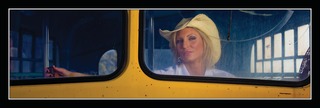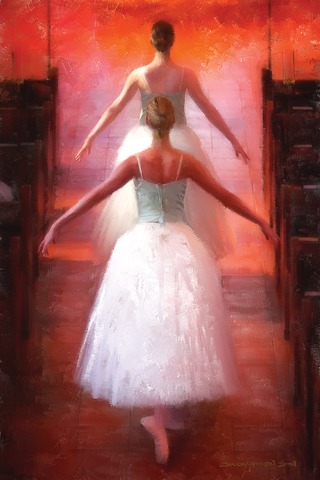Pretty as a Picture
The technology behind digital wide-format printing has delivered changes to the fine art photography market, and forever altered the way photographers approach their work.

Digital fine art photography is a highly exacting segment of the wide-format market, and one that spurs enormous creativity. The technology behind digital wide-format printing has delivered changes to the fine art photography market, and forever altered the way photographers approach their work.
Given this profound metamorphosis, we thought the time was right to talk with several veteran photographers about the transition to digital printing, and what opportunities and benefits that transition has conferred upon them.
Among very early converts to digital fine art photography was Eddie Tapp, owner of Georgia's Eddie Tapp Photography. Tapp opened his Atlanta photography business in 1973, and switched to digital in 1993. He reported that the switch to digital printing, and wide-format digital printing in particular, has had much to do with "crafting a workflow, and creating a solution for a product."
Wide-format digital printing, Tapp observed, has made it possible to achieve a high level of quality and consistency, with absolutely predictable results. Rarely does he have to make a second print because the first didn't turn out. Moreover, because of the Canon printers he uses, he can return to an image from two years ago, print it and get precisely the same results.
"Having a wide-format printer requires the means to mount and finish the images," he said. "If that isn't done in-house, having a partner such as a lab, a framer or a finishing specialist makes it productive, economic and profitable."
Tapp recalled that the transition to digital took place across the three stages in a photographer's workflow, which are capture, process and output.
"With the capture stage, the transition to digital was very easy, because you're primarily dealing with light, composition and exposure," he said. "However, the digital chip is far more sensitive to ambient light, and wrapping your head around photons compared to latent image is a bit of a challenge."
After the capture stage, the process stage required the acquisition of powerful computer systems and knowledge in how to properly use processing, file management and business applications. This stage, he says, involved perhaps the most intimidating and time-consuming learning curve of the three.
"Today, the output stage is by far the easiest, but that hasn't always been the case," he noted, adding that 12 to 15 years ago, this stage involved a battle. "Those of us who are color management savvy would have little or no major issues, but managing color back then was much more manual, if not hit or miss management, with a variety of settings that needed to be changed and tweaked."
Tapp believed color management has become easy to implement and automate, with terrific results. "Portrait, commercial, advertising, fine art, these are all areas where photographers are taking advantage of digital printing, allowing all of us to improve our craft creatively," he observed.
Highly Accessible
Like Tapp, Bruce Dorn, owner of IDCPhotoVideo.com in Prescott, AZ, is one of Canon's Print Masters and a Canon Explorer of Light. He is also a Corel Painter Master. He and his wife Maura Dutra produce a variety of digital art as digital originals. The bulk of their work originates with still capture, is finished as Corel Painter, and is printed on stretched canvas. "Our output is almost exclusively giclee canvases," Dorn said. "We're not a framing shop, we are not a matte shop. We are a really high-end image-making business."
Dorn's photography centers on classical, folk and tribal dance, as well as New Western imagery, such as cowboys and landscapes. In addition, he guides safaris to Tanzania and Botswana, and focuses some work on Africana. Dutra's subject matter includes still lifes, landscape work and some portraiture. Their work is distributed internationally in open-edition form. "Some of our work will show up in greeting cards, calendars, placemats, decorative tiles, anywhere where artsy imagery might be reproduced in mass production," Dorn reported.
Dorn and Dutra own Canon printers in 24-, 48- and 60-inch formats. "Prior to last decade's introduction of pigment jet printers, I wouldn't have dreamed of making large-format prints," Dorn said.
"The advent of pigment-based digital printers opened up opportunities for all the things we do in printing. It was ridiculous before, and now highly accessible and not at all difficult. You'd really have to have a compelling reason to stick with film, unless it's archival, and it's something that you captured on film decades ago and now it must be transferred to digital. The first large-format printing we ever took on paid for our first printers—and made us a profit."
Dorn stressed he was doing no printing before this transformation. "It simply wasn't accessible to the small shop," he said, noting Iris machines were selling for the cost-prohibitive figure of $60,000, before the sudden emergence of machines costing less than $3,000 capable of printing to the same scale.
"We went from providing only digital files, to providing both digital files and display prints of heroic scale," he recounted. "The whole arena of printing was suddenly open to us. We hadn't planned on a business model of offering prints, but now we can and do. We've won a number of fine art competitions, and now have a segment of our business based upon wide-format printing. We were able to go from zero to international recognition in less than a year. In the process, I became one of Canon's principal teachers in the art of wide-format printing."
Calling he and his wife "clearly early adopters," Dorn said now that they have the wide-format printing component of their business up and thriving, they are attempting to exploit the latest technology advancement in digital cameras, HD video capture. These days, he adds, it's not sufficient to be a jack of all trades. You really have to a master of all trades. "So we'll continue to see whatever technology comes down the pike, and try to exploit it," he concluded.
The Immediacy is Digital
Another photographer who has embraced wide-format digital photography is Canon Explorer of Light Clay Blackmore, owner of Rockville, MD-based Clay & Company. Primarily a wedding portrait photographer, Blackmore spends a third of each year educating other photographers in how to pose, light and refine.
"I'm all digital," he said. "I'm a film lover, and I hated to give it up, but it sees very little use, because of Canon comfort. Right now, the immediacy is all digital. When I shoot film I have to wait. And the [digital] cameras are all so good; the digital files are surpassing the film."
Blackmore reported the transition to digital wasn't difficult, and was made easier because, he said, "I've always surrounded myself with good people, and the techies around me are good with calibration software and digital workflow."
As a way of pointing out opportunities now available in wide-format digital fine-art photography, he cited an assignment 18 months ago for the opening of the Waldorf Astoria Park City in Park City, UT. The hotel wanted 1,500 framed, matted and signed pieces, all printed in-house. Clay & Company grew very familiar with its Canon printers on that project, turning out 1,500 prints in a week to 10 days on the printers. Framing took another three months, he added.
The framed photos, he said, "were infrared black-and-whites of aspen trees . . . I was in the right place at the right time. The hotel is on the mountain in Park City, and these images were mountain scenes. We decorated the rooms."
Framed photography went into hallways, common areas and 280 rooms, including one that featured 15 of Clay & Company's photographs.
On a day-to-day basis, the company handles many bar mitzvahs, creating photo images of teens living out their fantasies garbed as pro baseball players, race car drivers or rock stars. "I print out huge posters, and plaster the entire room where the bar mitzvah will be held with these posters," Blackmore said.
His ability to shoot landscapes comes in handy in his work for a number of private golf clubs in Maryland, which hire him to shoot color and black-and-white images 30 to 50 inches wide of popular settings on the links, such as the 18th hole. The images are used both to decorate rooms in clubhouses, and as mounted and framed 30-inch photos that serve as golf tournament prizes.
One of the most gratifying aspects of his work is substrate variety. "Some of the papers, I'm so happy with," he said, pointing to Canon Polished Rag as an example. "It feels heavy, feels substantial and the customer can see and feel the difference. I have a variety of papers, and am always changing them. We're always playing with some of the canvases and papers."
An Encompassing Space
One last happy convert to digital is Jon Sherman, president of Brooklyn-based Flavor Paper, which started as a New Orleans wallpaper company nine years ago, before moving to New York in 2009. The company began embracing digital output about three years ago, but only has been doing its own in-house digital production for the last 18 months, Sherman said. "We've traditionally been a hand-screened wallpaper company," he added. "Going digital has allowed us to utilize our millions of colors, fine detail and grand scale."
"Most of our digital wallpapers are all photography, and we work with a number of photographers that will be increasing exponentially soon."
Asked the greatest benefit he derives from wide-format digital fine-art photography, Sherman doesn't hesitate. "It creates more of a transporting event, that takes you to another place," he said. "A patterned wallpaper puts you into a mood or a feel, based on the pattern and color. But with a digital print you can change the entire environment into an encompassing space where the viewer is put into the image. That's what most photographers like about working with us. The viewer becomes one with the details."





































